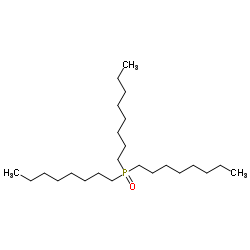trioctylphosphane oxide

trioctylphosphane oxide structure
|
Common Name | trioctylphosphane oxide | ||
|---|---|---|---|---|
| CAS Number | 78-50-2 | Molecular Weight | 386.635 | |
| Density | 0.9±0.1 g/cm3 | Boiling Point | 408.8±0.0 °C at 760 mmHg | |
| Molecular Formula | C24H51OP | Melting Point | 50-52 °C(lit.) | |
| MSDS | Chinese USA | Flash Point | 259.8±21.5 °C | |
| Symbol |

GHS05 |
Signal Word | Danger | |
|
L-cysteine-capped core/shell/shell quantum dot-graphene oxide nanocomposite fluorescence probe for polycyclic aromatic hydrocarbon detection.
Talanta 146 , 780-8, (2015) Environmental pollutants, such as the polycyclic aromatic hydrocarbons (PAHs), become widely distributed in the environment after emission from a range of sources, and they have potential biological effects, including toxicity and carcinogenity. In this work,... |
|
|
Luminescent determination of quinolones in milk samples by liquid chromatography/post-column derivatization with terbium oxide nanoparticles.
J. Chromatogr. A. 1405 , 126-32, (2015) The usefulness of terbium oxide nanoparticles (Tb4O7NPs) as post-column derivatizing reagent for the liquid chromatographic determination of residues of quinolone antibiotics in milk samples has been studied. Seven quinolones of veterinary use have been chose... |
|
|
Removal of acetic acid from simulated hemicellulosic hydrolysates by emulsion liquid membrane with organophosphorus extractants.
Bioresour. Technol. 192 , 340-5, (2015) Selective removal of acetic acid from simulated hemicellulosic hydrolysates containing xylose and sulfuric acid was attempted in a batch emulsion liquid membrane (ELM) system with organophosphorus extractants. Various experimental variables were used to devel... |
|
|
Structure determination and modeling of monoclinic trioctylphosphine oxide.
Acta Crystallogr. C Struct. Chem. 71(Pt 3) , 239-41, (2015) Trioctylphosphine oxide (TOPO), C(24)H(51)OP, was recrystallized from ambient evaporation in acetone. TOPO single crystals form with a monoclinic P2(1)/c structure. Fourier transform IR (FT-IR) spectroscopy captures the characteristic stretching modes from th... |
|
|
Integration of CdSe/CdSexTe1-x Type-II Heterojunction Nanorods into Hierarchically Porous TiO2 Electrode for Efficient Solar Energy Conversion.
Sci. Rep. 5 , 17472, (2015) Semiconductor sensitized solar cells, a promising candidate for next-generation photovoltaics, have seen notable progress using 0-D quantum dots as light harvesting materials. Integration of higher-dimensional nanostructures and their multi-composition varian... |
|
|
Asymmetric flow field-flow fractionation coupled to inductively coupled plasma mass spectrometry for the quantification of quantum dots bioconjugation efficiency.
J. Chromatogr. A. 1422 , 247-52, (2015) Hyphenation of asymmetric flow field-flow fractionation (AF4) to an on-line elemental detection (inductively coupled plasma-mass spectrometry, ICP-MS) is proposed as a powerful diagnostic tool for quantum dots bioconjugation studies. In particular, conjugatio... |
|
|
Band structure engineering via piezoelectric fields in strained anisotropic CdSe/CdS nanocrystals.
Nat. Commun. 6 , 7905, (2015) Strain in colloidal heteronanocrystals with non-centrosymmetric lattices presents a unique opportunity for controlling optoelectronic properties and adds a new degree of freedom to existing wavefunction engineering and doping paradigms. We synthesized wurtzit... |
|
|
Near-Infrared Emitting CuInSe₂/CuInS₂ Dot Core/Rod Shell Heteronanorods by Sequential Cation Exchange.
ACS Nano 9 , 11430-8, (2015) The direct synthesis of heteronanocrystals (HNCs) combining different ternary semiconductors is challenging and has not yet been successful. Here, we report a sequential topotactic cation exchange (CE) pathway that yields CuInSe2/CuInS2 dot core/rod shell nan... |
|
|
Engineering multifunctional magnetic-quantum dot barcodes by flow focusing.
Chem. Commun. (Camb.) 47(14) , 4195-7, (2011) A simple one-step flow focusing method was used to embed both magnetic nanoparticles and quantum dots in microbeads in controlled ratios to generate a large library of molecular barcodes for biological applications. |
|
|
Improved efficiency of bulk heterojunction hybrid solar cells by utilizing CdSe quantum dot-graphene nanocomposites.
Phys. Chem. Chem. Phys. 16(24) , 12251-60, (2014) We present a significant efficiency enhancement of hybrid bulk heterojunction solar cells by utilizing CdSe quantum dots attached to reduced graphene oxide (rGO) as the electron accepting phase, blended with the PCPDTBT polymer. The quantum dot attachment to ... |